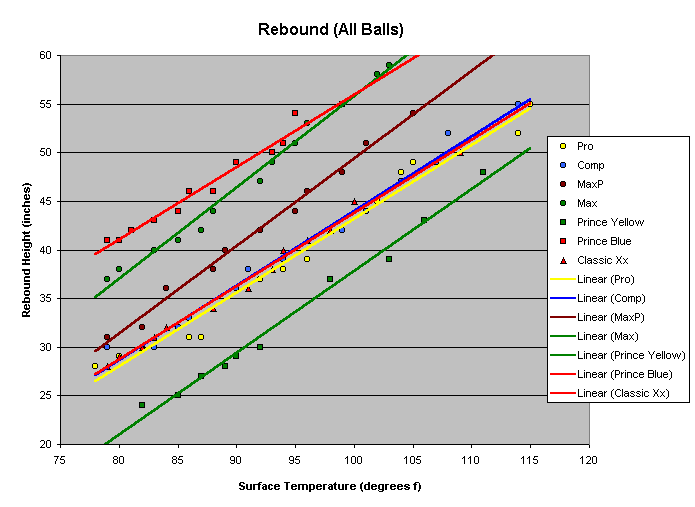
To see how the other balls compare with the Pro, here are the rebound results for all the balls tested. Linear regression trend lines have been added for each ball.

The above graph shows rebound height. It does not show hang time. For more information on the difference between rebound height and hang time, see the section Fun with Hang Time.
In the following sections, both rebound height and hang time for each ball are compared to the Pro, when each ball is at a surface temperatue of 95f. Note that the slope of each trend line is slightly different, so differences in rebound change somewhat as surface temperature changes.
Prince Yellow Dot
The Prince Yellow Dot had the lowest trend line of all the balls, showing about a 13% decrease in rebound height, and a 7% decrease in hang time, compared to the Pro.
Yellow Dot
The Yellow Dot in the drop test had a nearly identical trend line to the Pro, showing approximately a 1% increase in hang time, and about a 3% increase in rebound height.
Comp
The Comp is advertised as having 10% more hang time than the Pro. The Comp in the drop test had an almost identical trend line to the Pro and the Yellow Dot, showing approximately a 1% increase in hang time, and about a 3% increase in rebound height.
MaxP
The MaxP is advertised as having 20% more hang time than the Pro. The MaxP in the drop test had approximately 7% more hang time than the Pro, and about 15% more rebound height than the Pro.
Dunlop advertises the MaxP as having "instant bounce". I’m not sure what “instant bounce” is, but the MaxP only bounced about 3” higher than the Pro at 80f. (Does the Pro have instant bounce too?)
Max
The Max is advertised as having 40% more hang time than the Pro. The Max in the drop test had about 14% more hang time than the Pro, and about 31% more rebound height than the Pro.
Dunlop also advertises the Max as having "instant bounce". The Max does better than the MaxP in this department, but “instant bounce” is probably still best left as a marketing slogan.
Prince Blue Dot
The Prince Blue Dot had the highest trend line of any ball tested. At surface temperatures below 100f, the Prince Blue Dot had the highest rebound height. The Prince Blue Dot had about 15% more hang time than the Pro, and about 33% more rebound height than the Pro.
Prince does not advertise “instant bounce”, but the Prince Blue Dot came closest to that idea of any squash ball tested. At 80f, the Prince Blue Dot bounced about as high as the Pro at 100f.
The drop test compares the relative bounce of each ball. It will not show how a ball will bounce during play on all courts. But comparing relative bounce provides useful information. Once you know how a particular ball plays at a particular surface temperature on a particular court, you will know approximately how the other balls will play on that court.
A factor affecting bounce, which is not shown in the drop test, is friction. A drive will rebound from the floor higher than a soft shot which falls the same vertical distance. The drive will cause the ball to grip and "sit up" (bounce higher) compared to the soft shot.
New balls were used for the drop test. Worn balls bounce less than new balls. Only one ball of each model was tested. Dunlop and Prince likely have variances in their manufacturing. Testing the size and frequency of those variances would be helpful, but very time consuming.
The terms "faster", "livelier", and "more hang time" are commonly used to describe the Comp, MaxP, Max, and Prince Blue Dot balls. Those terms are better restated as "bounces higher at the same surface temperature". However, this idea can be misleading when “faster” balls are used at lower surface temperatures (which is typically the case).
"Faster balls" can have less hang time than "slower balls", depending on the their respective surface temperatures. The MaxP at 95f bounced less than the Pro at 105f. The Max at 88f bounced less than the MaxP at 100f. These surface temperature differences are important, because as shown later, the players measured in the study got Yellow Dot and Pro balls into a wide range of temperatures (82f-109f).
Some players say that the Max and Prince Blue Dot balls “bounce like a racquetball”. An Ektelon racquetball was drop tested with a surface temperature of 68f. The rebound height is compared to the Max at 93f and the Prince Blue Dot at 93f in the following chart:
Ball |
Rebound Height |
Racquetball at 68f |
93" |
Max at 93f |
49" |
Prince Blue Dot at 93f |
50" |
The 68f racquetball bounced about 90% higher than the 93f Max and 93f Prince Blue Dot balls.